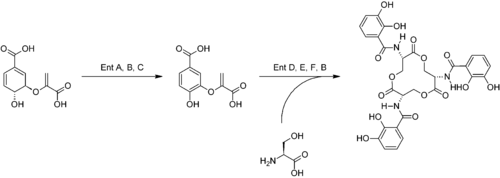
Enterobactin
Encyclopedia
Enterobactin is a high affinity siderophore
that acquires iron
for microbial systems. It is primarily found in Gram-negative
bacteria, such as Escherichia coli
and Salmonella typhimurium.
Enterobactin is the strongest siderophore known, binding to the ferric ion (Fe3+) with the affinity
(K = 1052 M−1). This value is substantially larger than even some synthetic metal chelators, such as EDTA
(Kf,Fe3+ ~ 1025 M−1). [3] Due to its high affinity, enterobactin is capable of chelating
even in environments where the concentration of ferric ion is held very low, such as within living organisms. Pathogen
ic bacteria
can steal iron from other living organisms using this mechanism, even though the concentration of iron is kept extremely low due to the toxicity of free iron.
, an aromatic amino acid
precursor
, is converted to 2,3-dihydroxybenzoic acid
(DHB) by a series of enzyme
s, EntA, EntB and EntC. An amide
linkage of DHB to L-serine is then catalyzed by EntD, EntE, EntF and EntB. Three molecules of the DHB-Ser formed undergo intermolecular cyclization, yielding enterobactin. [5] Although a number of stereoisomers are possible due to the chirality
of the serine residues, only the Δ-cis isomer
is metabolically active.

in bacterial cells triggers secretion of enterobactin into the extracellular environment, causing formation of an coordination complex "FeEnt" wherein ferric ion is chelated to the conjugate base of enterobactin. In Escherichia coli
, FepA in the bacterial outer membrane then allows entrance of FeEnt to the bacterial periplasm. FepB,C,D and G all participate in transport of the FeEnt through the inner membrane by means of an ATP-binding cassette transporter.
Due to the extreme iron binding affinity of enterobactin, it is necessary to cleave FeEnt with ferrienterobactin esterase to remove the iron. This degradation yields three 2,3-dihyroxybenzoyl-L-serine units. Reduction
of the iron (Fe3+ to Fe2+) occurs in conjunction with this cleavage, but no FeEnt bacterial reductase
enzyme has been identified, and the mechanism for this process is still unclear. The reduction potential for Fe3+/Fe2+–enterobactin complex is pH dependent and varies from −0.57 V (vs NHE) at pH 6 to −0.79 V at pH 7.4 to −0.99 at pH values higher than 10.4.
Siderophore
Siderophores are small, high-affinity iron chelating compounds secreted by grasses and microorganisms such as bacteria and fungi...
that acquires iron
Iron
Iron is a chemical element with the symbol Fe and atomic number 26. It is a metal in the first transition series. It is the most common element forming the planet Earth as a whole, forming much of Earth's outer and inner core. It is the fourth most common element in the Earth's crust...
for microbial systems. It is primarily found in Gram-negative
Gram-negative
Gram-negative bacteria are bacteria that do not retain crystal violet dye in the Gram staining protocol. In a Gram stain test, a counterstain is added after the crystal violet, coloring all Gram-negative bacteria with a red or pink color...
bacteria, such as Escherichia coli
Escherichia coli
Escherichia coli is a Gram-negative, rod-shaped bacterium that is commonly found in the lower intestine of warm-blooded organisms . Most E. coli strains are harmless, but some serotypes can cause serious food poisoning in humans, and are occasionally responsible for product recalls...
and Salmonella typhimurium.
Enterobactin is the strongest siderophore known, binding to the ferric ion (Fe3+) with the affinity
Chemical affinity
In chemical physics and physical chemistry, chemical affinity is the electronic property by which dissimilar chemical species are capable of forming chemical compounds...
(K = 1052 M−1). This value is substantially larger than even some synthetic metal chelators, such as EDTA
EDTA
Ethylenediaminetetraacetic acid, widely abbreviated as EDTA , is a polyamino carboxylic acid and a colourless, water-soluble solid. Its conjugate base is named ethylenediaminetetraacetate. It is widely used to dissolve limescale. Its usefulness arises because of its role as a hexadentate ligand...
(Kf,Fe3+ ~ 1025 M−1). [3] Due to its high affinity, enterobactin is capable of chelating
Chelation
Chelation is the formation or presence of two or more separate coordinate bonds between apolydentate ligand and a single central atom....
even in environments where the concentration of ferric ion is held very low, such as within living organisms. Pathogen
Pathogen
A pathogen gignomai "I give birth to") or infectious agent — colloquially, a germ — is a microbe or microorganism such as a virus, bacterium, prion, or fungus that causes disease in its animal or plant host...
ic bacteria
Bacteria
Bacteria are a large domain of prokaryotic microorganisms. Typically a few micrometres in length, bacteria have a wide range of shapes, ranging from spheres to rods and spirals...
can steal iron from other living organisms using this mechanism, even though the concentration of iron is kept extremely low due to the toxicity of free iron.
Structure and biosynthesis
Chorismic acidChorismic acid
Chorismic acid, more commonly known as its anionic form chorismate, is an important biochemical intermediate in plants and microorganisms...
, an aromatic amino acid
Amino acid
Amino acids are molecules containing an amine group, a carboxylic acid group and a side-chain that varies between different amino acids. The key elements of an amino acid are carbon, hydrogen, oxygen, and nitrogen...
precursor
Precursor (chemistry)
In chemistry, a precursor is a compound that participates in the chemical reaction that produces another compound. In biochemistry, the term "precursor" is used more specifically to refer to a chemical compound preceding another in a metabolic pathway....
, is converted to 2,3-dihydroxybenzoic acid
2,3-Dihydroxybenzoic acid
2,3-Dihydroxybenzoic acid is a dihydroxybenzoic acid, a type of organic compound. The colourless solid occurs naturally, being formed via the chorismic acid pathway. It is incorporated into various siderophores, which are molecules that strongly complex iron ions for absorption into bacteria...
(DHB) by a series of enzyme
Enzyme
Enzymes are proteins that catalyze chemical reactions. In enzymatic reactions, the molecules at the beginning of the process, called substrates, are converted into different molecules, called products. Almost all chemical reactions in a biological cell need enzymes in order to occur at rates...
s, EntA, EntB and EntC. An amide
Amide
In chemistry, an amide is an organic compound that contains the functional group consisting of a carbonyl group linked to a nitrogen atom . The term refers both to a class of compounds and a functional group within those compounds. The term amide also refers to deprotonated form of ammonia or an...
linkage of DHB to L-serine is then catalyzed by EntD, EntE, EntF and EntB. Three molecules of the DHB-Ser formed undergo intermolecular cyclization, yielding enterobactin. [5] Although a number of stereoisomers are possible due to the chirality
Chirality (chemistry)
A chiral molecule is a type of molecule that lacks an internal plane of symmetry and thus has a non-superimposable mirror image. The feature that is most often the cause of chirality in molecules is the presence of an asymmetric carbon atom....
of the serine residues, only the Δ-cis isomer
Isomer
In chemistry, isomers are compounds with the same molecular formula but different structural formulas. Isomers do not necessarily share similar properties, unless they also have the same functional groups. There are many different classes of isomers, like stereoisomers, enantiomers, geometrical...
is metabolically active.

Mechanism
Iron deficiencyIron deficiency (medicine)
Iron deficiency is one of the most common of the nutritional deficiencies. Iron is present in all cells in the human body, and has several vital functions...
in bacterial cells triggers secretion of enterobactin into the extracellular environment, causing formation of an coordination complex "FeEnt" wherein ferric ion is chelated to the conjugate base of enterobactin. In Escherichia coli
Escherichia coli
Escherichia coli is a Gram-negative, rod-shaped bacterium that is commonly found in the lower intestine of warm-blooded organisms . Most E. coli strains are harmless, but some serotypes can cause serious food poisoning in humans, and are occasionally responsible for product recalls...
, FepA in the bacterial outer membrane then allows entrance of FeEnt to the bacterial periplasm. FepB,C,D and G all participate in transport of the FeEnt through the inner membrane by means of an ATP-binding cassette transporter.
Due to the extreme iron binding affinity of enterobactin, it is necessary to cleave FeEnt with ferrienterobactin esterase to remove the iron. This degradation yields three 2,3-dihyroxybenzoyl-L-serine units. Reduction
Redox
Redox reactions describe all chemical reactions in which atoms have their oxidation state changed....
of the iron (Fe3+ to Fe2+) occurs in conjunction with this cleavage, but no FeEnt bacterial reductase
Reductase
-Examples:* 5-alpha reductase* Dihydrofolate reductase* HMG-CoA reductase* Methemoglobin reductase* Ribonucleotide reductase* Thioredoxin reductase* E. coli nitroreductase* Methylenetetrahydrofolate reductase...
enzyme has been identified, and the mechanism for this process is still unclear. The reduction potential for Fe3+/Fe2+–enterobactin complex is pH dependent and varies from −0.57 V (vs NHE) at pH 6 to −0.79 V at pH 7.4 to −0.99 at pH values higher than 10.4.

